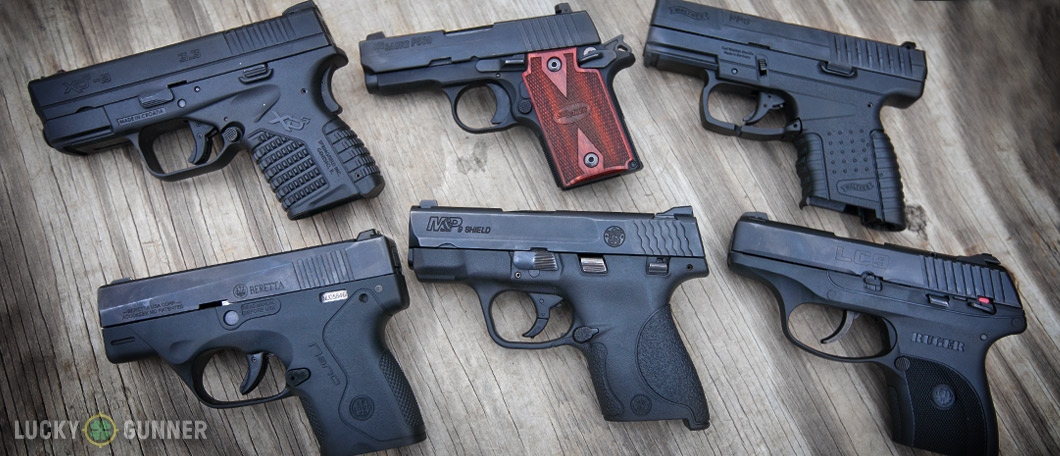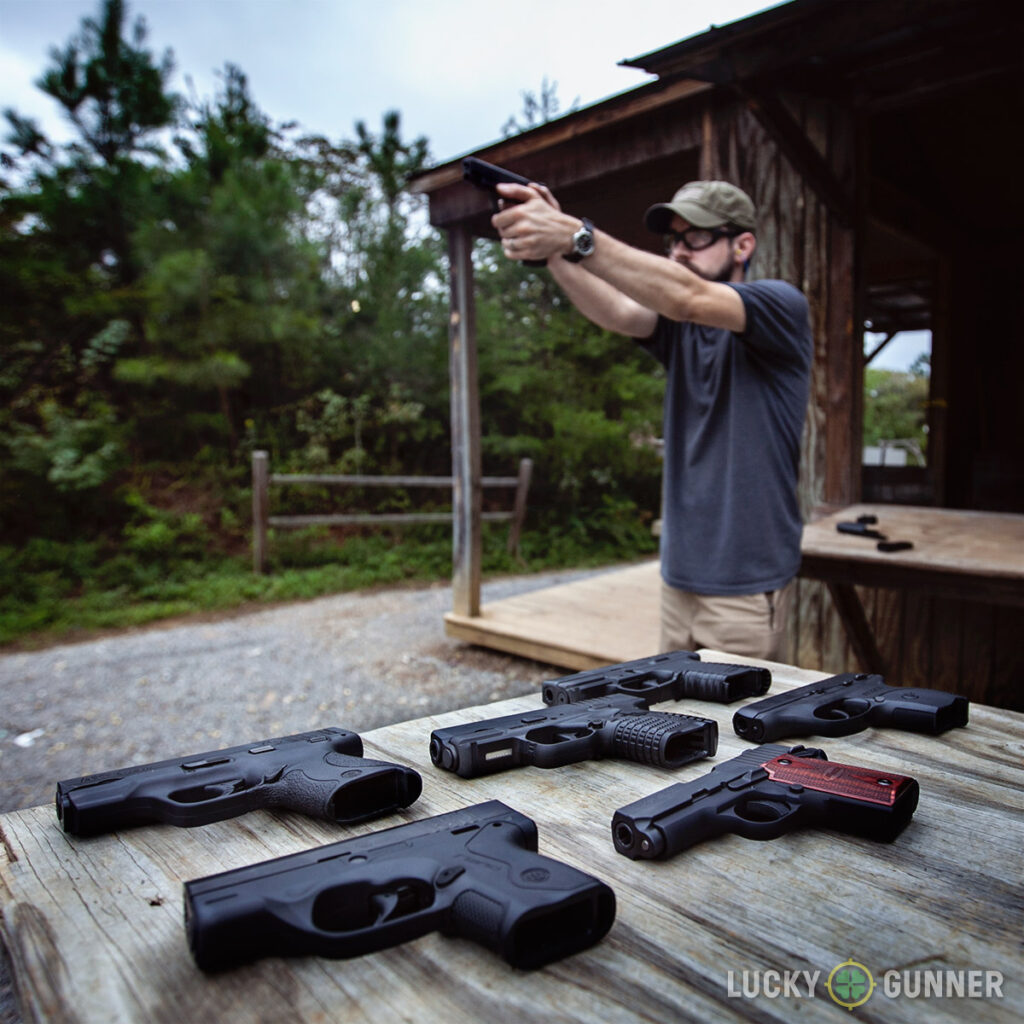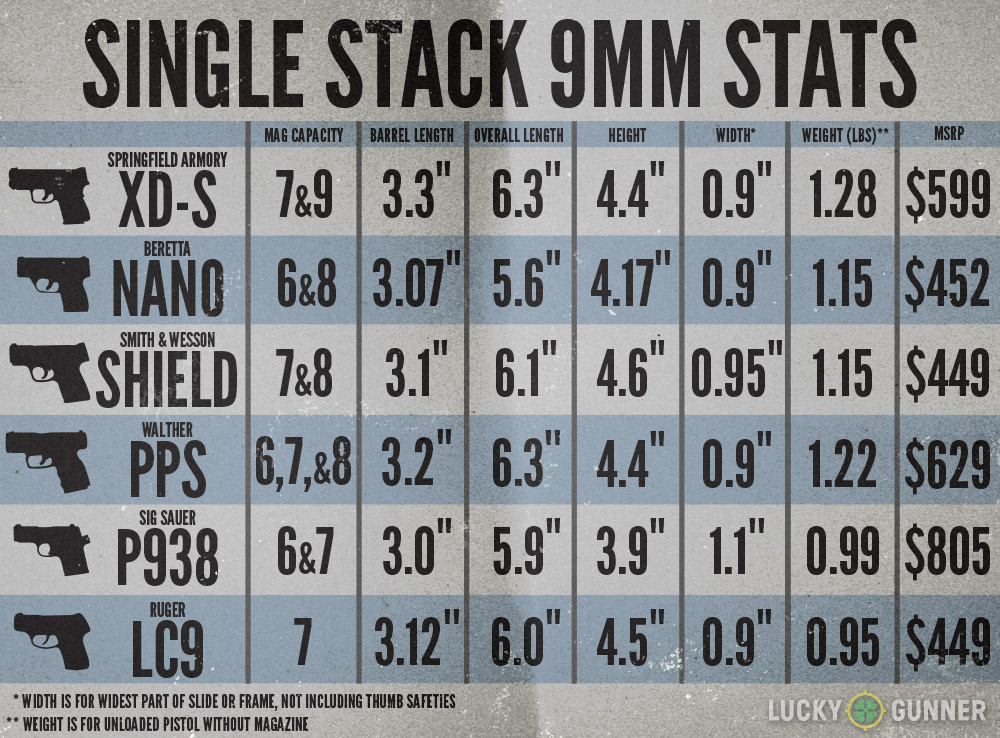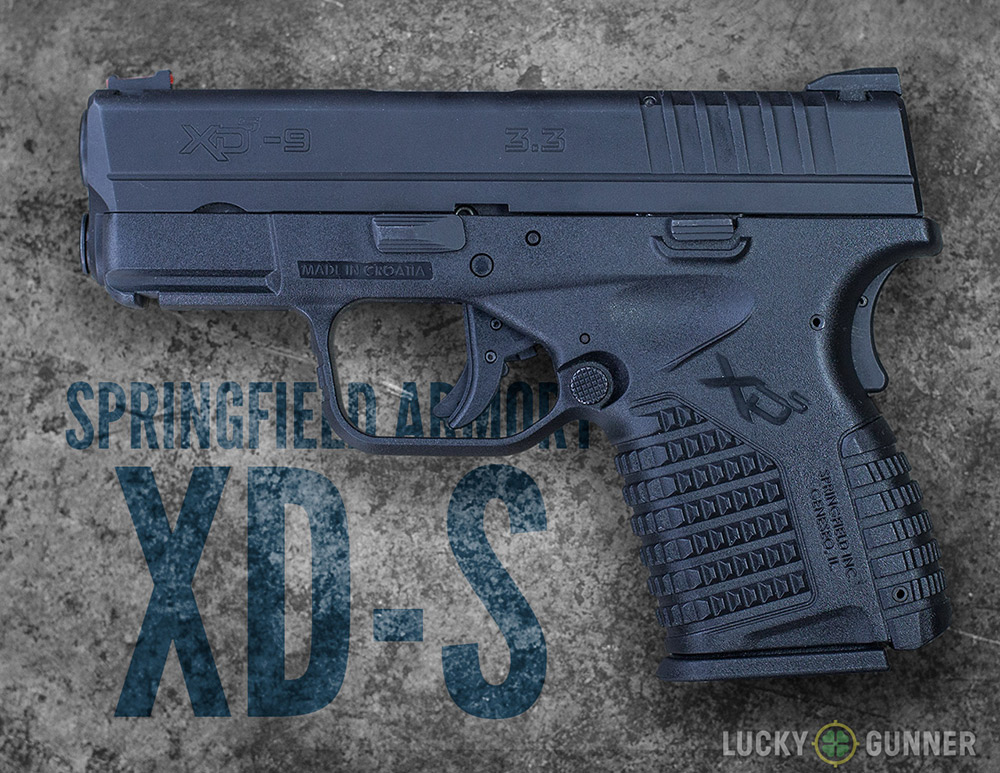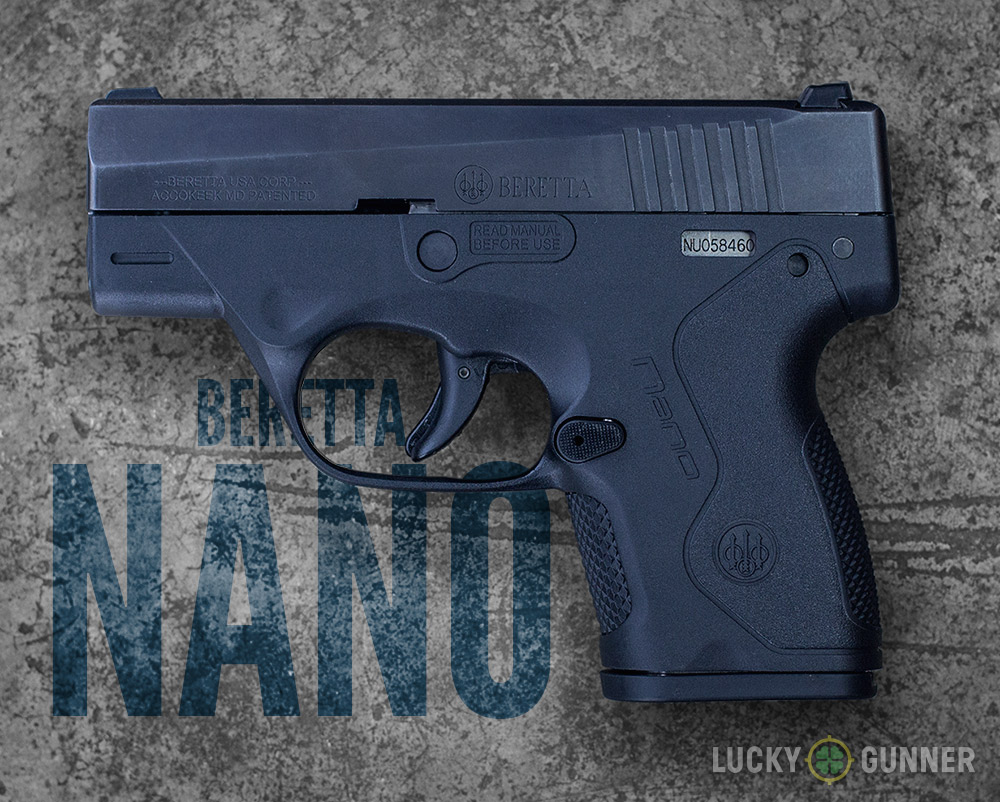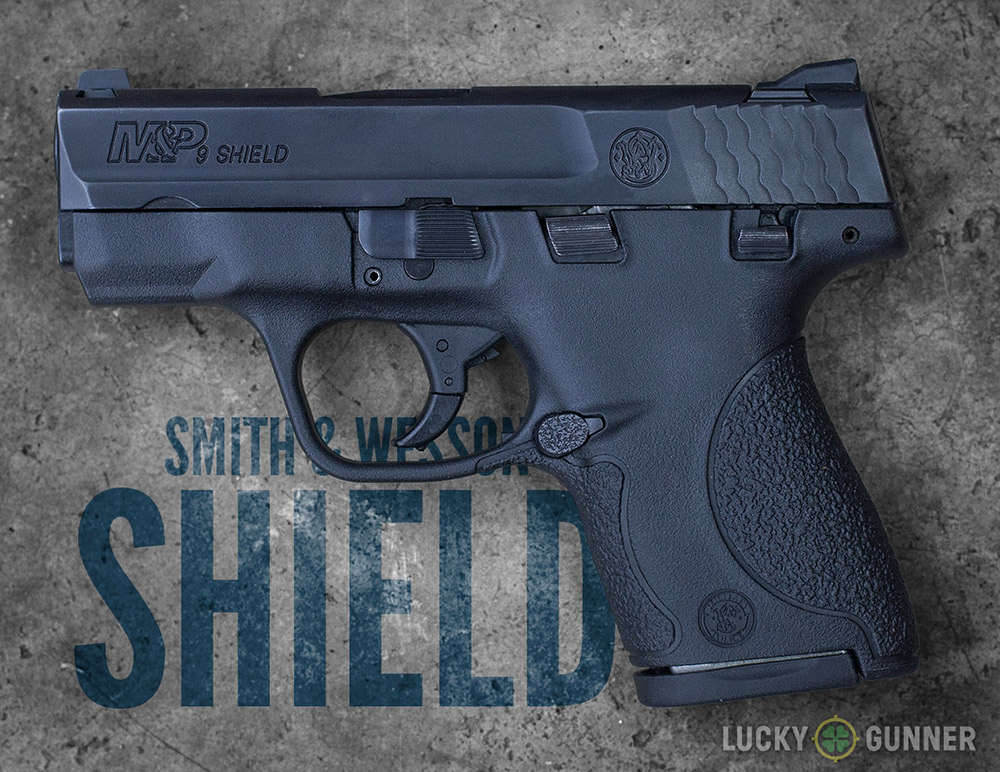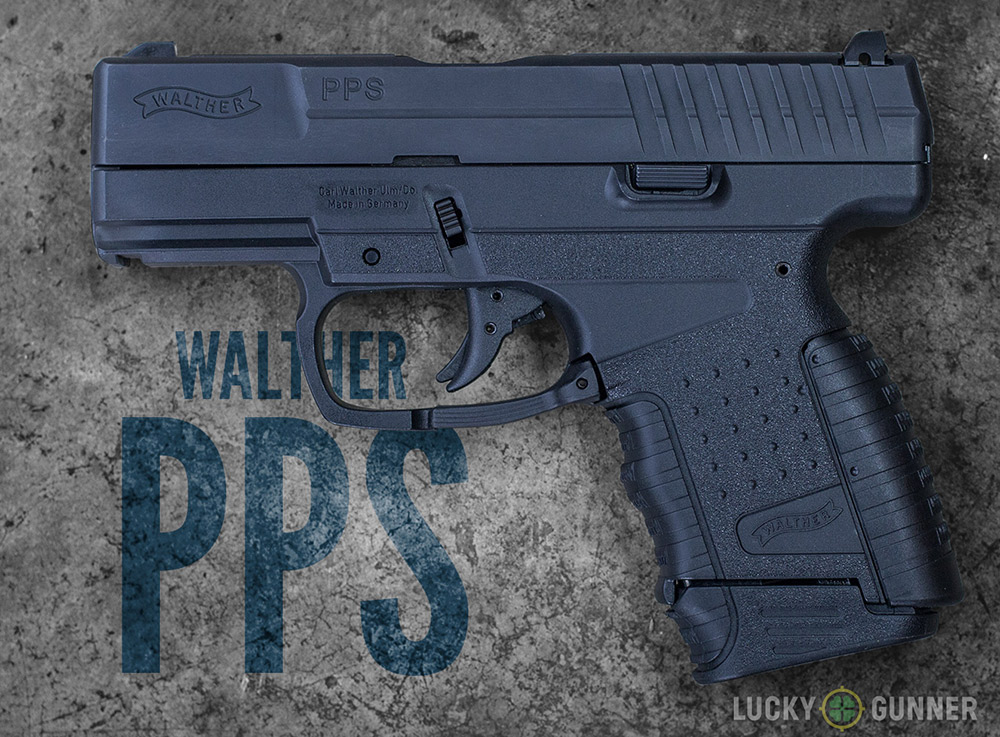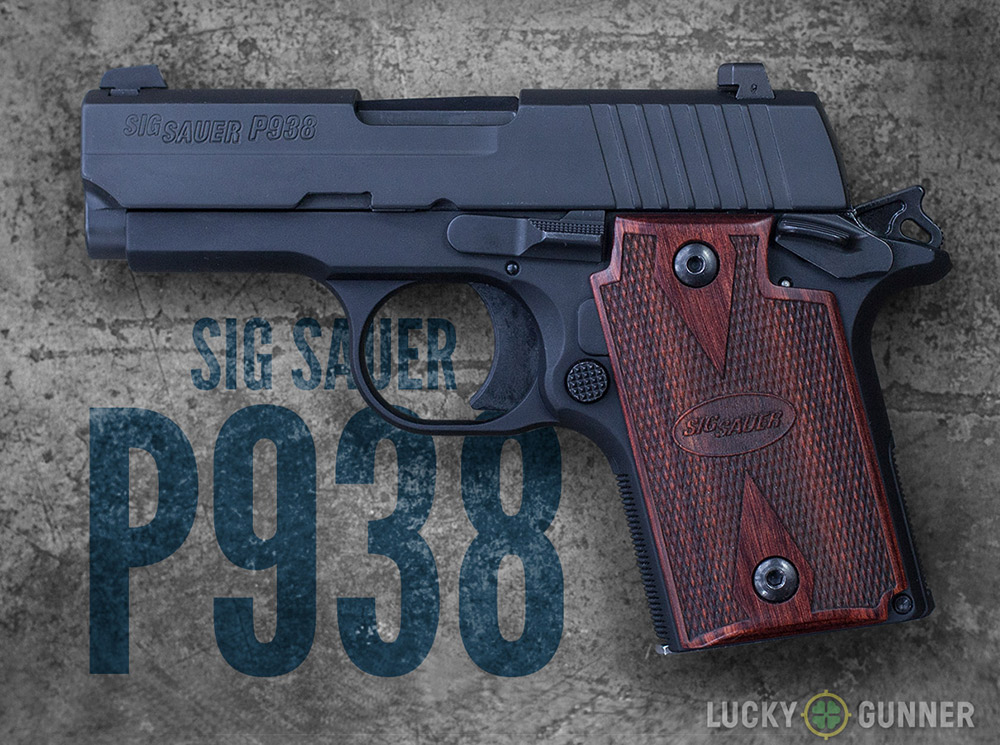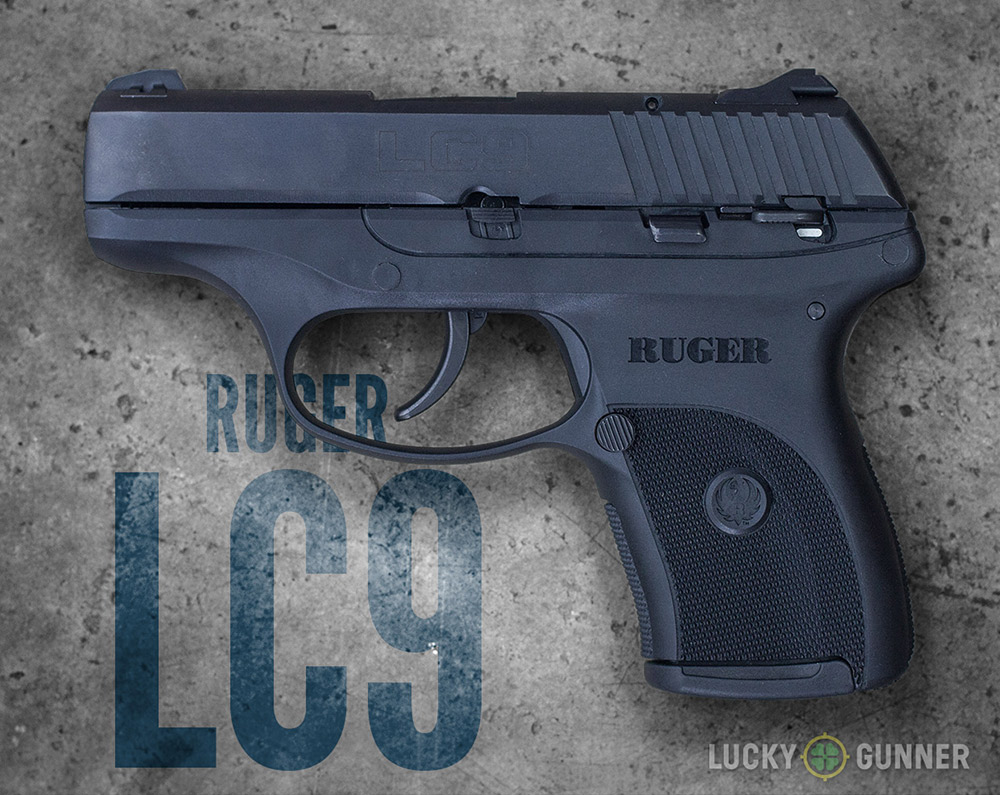UPDATE (3/28/2016): Since we first published this piece, Glock released their entry to the single stack 9mm category with the G43. We tested the G43 extensively and did a four-part review over several months:
G43 Part 1: The first 500 rounds
G43 Part 2: Accuracy and Reliability Report
G43 Part 3: Fighting with the Glock 43
G43 Part 4: Final Update
One of our Lucky Gunner Lounge contributors also gave his thoughts about the G43 compared to the Sig P938 as well as the single stack 9mm Boberg XR9-S.
I also had the chance to try out the updated version of Ruger’s single stack 9mm, and did a brief review of the Ruger LC9s.
—
Just as the concealed carry market was heating up in the mid-1990s, Glock released what would be one of the most successful carry pistols of the century; the “Baby Glock” G26. In 1995, polymer framed guns were still uncommon, and the 26 offered a lot of firepower in a very lightweight package. Around the same period, the new start-up firearm company Kahr found an easy audience for their single stack, steel framed 9mm pistols. Their polymer-framed Kahr P9 followed in 1999, which was one of the first 9mm pistols that was both lighter and slimmer than the Glock 26.
As well received as these pistols were, the market demanded smaller and lighter designs. It wasn’t until 2007 with the release of the Kel-Tec PF9 that the flood gates opened for the ultra-compact 9mm single stack pistol market. In a very short time frame, we’ve seen single stack nines from almost every major pistol maker (with the conspicuous exception of Glock).
I personally have a bias toward the slightly larger sub-compact double stack 9mm pistols like Smith & Wesson’s M&P Compact and the aforementioned Glock 26. They’re easier to shoot and allow a significant bump in magazine capacity. However, if concealability and comfort is the bigger priority, the single stack 9mm pistols often fall in a very attractive spot on the spectrum between power and shootability. They’re not as small as the little micro-.380 pistols, but they fire a round that’s considered more respectable in most self-defense circles.
Comparing Six Single Stack 9mm Pistols
Despite my current preference for the larger sub-compacts, I have carried several 9mm single stacks in the past, and I certainly understand the appeal. I pay close attention to all the new releases of single stack nines, and try to run a few rounds through them at the range when given the opportunity. Not too long ago, I noticed that most of the guys here at the Lucky Gunner headquarters either carry a Glock 26, or a single stack 9mm (except for one weirdo who swears by a Glock 33 in .357 Sig). A comparison review was really an inevitability, so last week a few of us went out to the range with a pile of 9mm ball ammo to make it happen.
The focus of our shooting time was on six main contenders: the Springfield Armory XD-S 3.3, the Beretta Nano, Smith and Wesson’s M&P Shield 9, the Walther PPS, the Sig Sauer P938 that I reviewed last month, and the Ruger LC9. We also tried out the 4-inch barreled version of the XD-S — aptly named the XD-S 4.0 — since I still had it in the LG armory from the review we ran in May. Finally, we ran a few rounds through my M&P 9c to get a feel for how all of these lightweight slim pistols compare to something slightly chunkier.
Below, we’ve got a full breakdown of our thoughts and observations on each pistol. For those who want to jump straight to the bottom line, here’s a quick 60-second video summary.
Video: 60-Second 9mm Shootout Summary
By the Numbers
Without the ability to handle all of these guns side by side in person, most people will resort to comparing their dimensions on paper. If you’re trying to decide which one to buy, this can be a helpful part of the process, so we made a quick reference chart for the six pistols we tested.
I should point out, however, that just looking at the numbers can be a bit deceiving. The measurements are all based on the extreme dimensions and don’t really take into account the overall shape of each pistol or the weight distribution, both of which make a significant difference when it comes to shooting and carrying these guns around all day in a holster.
For instance, the numbers don’t necessarily show it, but the Sig P938 feels like it’s in a completely different size class than the other five. It’s far less bulky, and all the controls are more easily accessible. That might be a good thing if you’re after concealability, but it could also mean that your hands will feel cramped when shooting.
The Walther PPS seems to be pretty close to the others in size, but what you can’t tell from looking at the chart is that the oversized trigger guard gives it a larger overall footprint. Comparing the dimensions is a good starting point, but if you’re seriously considering any of these pistols, it makes a lot of sense to try and get your hands on one before making any final decisions.
Reliability
As I’ve mentioned several times in the past, reliability should be the #1 criteria for choosing a self-defense firearm. What constitutes “reliable” versus “unreliable” is another issue altogether, and we could devote an entire series of articles to that subject alone. For this review, we fired roughly 900 rounds total. That might sound like a lot, but when spread over six firearms it’s a statistically insignificant amount. I’ve noted below when a gun exhibited reliability issues and what I believe to be the origin of the problem, but we can’t assume that these incidents are representative of a trend with that particular model. Nor can we assume that the absence of problems in the other guns is any indication that all samples of that model always perform equally well.
All of these guns can and will malfunction eventually if the circumstances are right. I intentionally selected guns for this review that come from manufacturers with at least a fairly good track record for producing firearms of consistent quality, but I know that doesn’t mean much for the one guy who gets a lemon. In general, I usually suggest making a determination about reliability based on a balanced consideration of the following factors:
- Manufacturer Warranty: Will the company fix it if it breaks? What’s their turnaround time? Is their customer service easy to deal with?
- Anecdotal Evidence: One guy on a forum who complains of a parts breakage is statistically meaningless. If your search reveals a dozen other first-hand reports of the same problem, then we’re somewhere between “isolated incident” and “actual data”. It still might not mean anything, but it’s at least worth incorporating into your overall decision.
- Firearms Instructors: What are the guys saying who run classes every week? They see thousands of rounds go through hundreds of different guns. Which ones do they see fail most often?
- Reliability Test: Once you buy the gun, the only thing that matters is whether your gun runs with your ammo. As an absolute minimum, I typically like to run at least 500 rounds of FMJ ammo and 50 rounds of my self-defense ammo with no malfunctions before I will carry the gun.
Okay, with that out of the way, let’s take a look at our findings from the range…
1. Springfield Armory XD-S 3.3″ 9mm
Dimensions and Features
- LxHxW: 6.3″ x 4.4″ x 0.9″
- Barrel Length: 3.3″
- Weight: 1.28 lbs.
- Magazine Capacity: Two 7-round flush-fitting magazines are included. 9-round extended magazines are available from Springfield Armory.
- Magazine Weight: 0.12 lbs. (7-round) and 0.19 lbs. (9-round)
- Action Type: Striker-fired/Double Action
- Sights: Fiber Optic Front, White Dot Rear
- External Safety Features: Grip safety must be depressed to fire (unlike other XD pistols, the slide can be retracted when the safety is not engaged), trigger safety
- Other Features: Included with 2 interchangeable backstraps, plastic injection-molded holster and magazine carrier.
- MSRP: $599 for black melonite slide, $669 for stainless
- Street Price: ~$450-$600
Impressions
Of the six pistols we tried out for the review, the XD-S is second in size and overall bulkiness only to the Walther PPS. It’s still very slim, and its owner has no complaints from carrying it every day in an inside the waistband holster. The flush-fitting 7-round magazines that are included with the pistol make it difficult to get a firm grip. The gun is much easier to shoot with an extended 9-round magazine. The 4-inch barreled version of the XD-S comes with one of each size, which we all thought should be the case with the 3.3-inch version as well.
One of the shooters felt that the checkering on the backstrap was overly aggressive, and made the recoil feel sharper than it actually was. This same shooter, who has slightly smaller than average hands, also thought the magazine release was too difficult to reach with the thumb of his shooting hand.
The bright red fiber optic front sight is a welcome change from the typical white three-dot sights that most other self-defense pistols carry. I’d rather see night sights as the standard option, especially at this price point, but the fiber optic is not a bad alternative. In rapid fire drills, the sights were easy to track, and the somewhat stiff striker-fired trigger was actually not too difficult to manage at speed. The extreme rear placement of the slide stop made it difficult to avoid contact when firing, which often prevented slide lock after the last shot in the magazine.
Aside from the magazine size, none of us noticed a huge difference when shooting the 4-inch version of the pistol versus the 3.3-inch. The 4.0″ feels a little better balanced, and might be a little quicker for target transitions, but there was only a slight difference in perceived recoil. However, these are pretty subjective observations and other XD-S 4.0″ owners have told us they noticed a more drastic improvement in their shooting with the longer barrel.
Recommendation
Based on my experience with the XD-S so far, I would have no problem carrying it if that’s what I was given. I don’t know if there’s enough here to justify actually buying one at the price point SA has chosen. The M&P Shield is very comparable in almost every way, and can easily be had for at least $100 less.
2. Beretta BU9 Nano 9mm
Dimensions and Features
- LxHxW: 5.6″ x 4.17″ x 0.9″
- Barrel Length: 3.07″
- Weight: 1.15 lbs.
- Magazine Capacity: One 6-round flush-fitting magazine and one 8-round extended magazine included.
- Magazine Weight: 0.10 lbs. (6-round) and 0.13 lbs. (8-round)
- Action Type: Striker-Fired/Double Action
- Sights: White 3-Dot
- External Safety Features: Trigger safety
- Other Features: Reversible magazine release, “snag-free” design with no protruding controls
- MSRP: $445
- Street Price: ~$380-$440
Impressions
Beretta’s entry into the single stack 9mm category seems to have a lot going for it. The overall dimensions are slightly smaller than any of the other five carry guns on our list, but the recoil was surprisingly soft. Its frame and slide are devoid of any interference from safeties, takedown levers, or slide stops, theoretically making it a “snag-free” design. Of the pistols we tested, it may be the best suited for true pocket carry.
Unfortunately, some of those features come with drawbacks when you actually fire the Nano. Like most of these guns, the smaller flush fitting magazine makes the grip too short and significantly more difficult to control under rapid fire. The low profile sights might not catch on your clothing, but they’re also tough to see. If you’re fan of the instinctive/point-shooting school of thought, that might not be such a big deal, but I also found that the Nano doesn’t point naturally, either. The slide seems awkwardly high, and I had to make a conscious effort to pull the front of the muzzle slightly upward when presenting the pistol to the target.
The lack of an external slide stop lever became a problem when the Beretta exhibited failures to extract early on. We could barely get through a full magazine without a double feed malfunction. I’m reluctant to be too hard on the Nano for the malfunctions because the gun wasn’t cleaned and lubricated prior to our range trip (although Beretta’s marketing would have you believe the Nano will run 1000 rounds with or without lube). A couple of drops of gun oil on the slide and the pistol seemed to do fine for the remainder of the range session. I mention the FTE’s because it illustrates a problem with not including a slide lock lever. Depending on how you run double feed malfunction clearance drills, the slide lock lever might be an integral part of the way you’ve trained your muscle memory. The same goes for reloads. If you prefer using the slide lock lever after inserting a fresh mag, well tough luck — the slide rack method is your only option on the Nano.
The trigger was not our favorite of the bunch, but not the worst, either. It’s a long-ish pull for a striker-fired pistol. My trigger pull gauge measured it at 8.5 lbs, but it honestly doesn’t feel quite that heavy when firing. There is no intermediate reset point, meaning the trigger must be completely released to its starting point before it can be squeezed again. More than anything, the long reset probably accounts for my less than stellar performance with the Nano during rapid fire drills.
Recommendation
I would be reluctant to recommend the Nano based on the difficulty we had with shooting it well. That said, most of our gripes come down to personal preference. The reliability issues we experienced may or may not be specific to the particular gun we were using, although a quick online search shows that we’re not the only ones who have had extraction problems with a Nano. Unless the snag-free design is an absolute must for you, there are probably better options on this list.
3. Smith & Wesson M&P Shield 9
Dimensions and Features
- LxHxW: 6.1″ x 4.6″ x 0.95″
- Barrel Length: 3.1″
- Weight (unloaded): 1.15 lbs.
- Magazine Capacity: One 7-round flush fitting and one 8-round extended magazine included.
- Magazine Weight: 0.13 lbs (7-round) and 0.15 lbs. (8-round)
- Action Type: Striker-Fired
- Sights: White 3-Dot
- External Safety Features: Two-part Hinged Trigger safety, Low-Profile Thumb Safety (also available without thumb safety)
- MSRP: $449
- Street Price: ~$340-$420
Impressions
Right up front, I’ll admit to a bias toward the M&P Shield, but that bias is based on a lot of experience. I’ve fired roughly 2500 rounds through a Shield with only two malfunctions ever, and carried it almost every day for bout 18 months before switching back to the M&P9c. Already being accustomed to the placement of the controls on the M&P series, I quickly felt at home with the Shield. I have never liked the external thumb safety, however. It’s not as easy to engage as the larger 1911-esque safety levers on the rest of the M&P series. Fortunately, S&W has responded to customer complaints about the safety and recently started offering a version of the Shield without the safety lever.
The other guys from the Lucky Gunner crew also seemed to like the Shield, though not as much as I do. They both reported more felt recoil than many of the other guns, especially when using the shorter 7-round magazine. Like all of the other guns on our list, I much prefer shooting the Shield with the extended 8-rounder, so their criticism there is understandable.
The trigger on the Shield we were using has been upgraded with parts from Apex Tactical, which gives it a more consistent and crisp break than the factory trigger. Compared to all the other pistols, this improvement was noticeable, but did not lead to any significant improvement in speed or accuracy. Despite being well used, the two magazines we had for the Shield were both very stiff and difficult to load to full capacity compared to the mags from the other guns.
Like the rest of the M&P series, the Shield is very light on frame texture which means some folks will find it difficult to get a firm grip on the pistol, especially with sweaty hands. I’m not too bothered by the lack of aggressive frame texture because it’s always much easier to add grip tape or a stipple job than to remove disagreeable texturing from the factory. The more problematic issue with the grip for me is the fact that the shape of the backstrap and trigger guard forces my firing hand lower on the grip than I would like. I also had this issue with the Nano and the Ruger LC9, but I mention it here because I think it may be partly to blame for the perceived increase in muzzle flip with the Shield.
Recommendation
For a gun in this size category, the Shield is my go-to recommendation. Of all the single stack 9mm pistols I’ve tried, the Shield offers the best balance of size, shootability, reliability, and price. On top of that, it has a wealth of aftermarket support in the form of holsters, sights, and other accessories. It may not be the best choice of the six for recoil sensitive shooters, but if that’s a major concern, this category of small 9mm pistols is probably best avoided anyway.
4. Walther PPS 9mm
Dimensions and Features
- LxHxW: 6.3″ x 4.4″ x 0.9″
- Barrel Length: 3.2″
- Weight: 1.22 lbs.
- Magazine Capacity: One 7-round extended magazine and one 8-round extended magazine included. 6-round flush-fitting magazines also available from Walther.
- Magazine Weight: 0.14 lbs. (7-round) and 0.15 lbs. (8-round)
- Action Type: Striker Fired, Double Action
- Sights: White 3-Dot
- External Safety Features: Trigger Safety, removing backstrap disables pistol, striker indicator on rear of slide (protrudes as trigger is squeezed)
- Other Features: Included with large and small size backstraps, paddle-style magazine release
- MSRP: $629
- Street Price: ~$525-$600
Impressions
Before the M&P Shield was released, I carried the Walther PPS on and off for a couple of years. I had very few complaints about the pistol for the time that I owned it and only switched to the Shield because it shared the same style magazine release as my other handguns.
The Walther PPS has been popular in some circles, but has never quite gained the same ubiquity as the other big names. On paper, it’s tied with the XD-S as the largest of the pistols we tried, but the shape of the trigger guard and the bulky magazine extensions make it slightly chunkier overall. But it still maintains a slim profile with the only protrusion being its easy-to-reach slide stop lever. The PPS might feel a little smaller with a flush-fitting 6-round magazine, but we didn’t have one to try, and the standard version of the pistol ships with only extended magazines holding 7 and 8 rounds. The Walther is the sole carry pistol on our list that has three different sizes of factory magazines available.
The large overall dimensions pay off when it comes to shooting the Walther. At the range, we all agreed that the Walther was the most comfortable test gun with the least amount of felt recoil. The smooth factory trigger is easy to use a full speed. I’d put it up against the factory trigger on any other small striker fired carry gun.
Users with large hands will appreciate the amount of grip real estate available with the extended 8-round magazine and the large backstrap inserted. The smaller backstrap allows the slim grip to fit into smaller hands just as easily. When I owned a Walther myself, some of my friends who shot the gun had issues with their fingers getting pinched between the mag well and top of the magazine extension. None of us experienced this issue during our test, but people whose hands naturally rest in that gap might find shooting the Walther to be a bit painful.
Personally, my biggest complaint with the Walther is the paddle-style magazine release, similar to what’s found on other modern polymer Walther and HK pistols. It’s not really that difficult to get used to, but if you normally shoot pistols with traditional thumb style mag buttons, mag changes with the Walther always require some extra mental effort.
One little “bonus” feature that I’ve seen on very few other pistols is the Walther’s striker indicator, which protrudes slightly from the rear of the slide as the trigger is squeezed. If you place your thumb on the back of the slide when holstering, the striker indicator serves as a warning if the trigger becomes caught on anything. This is one rare example of a safety feature that makes a ton of sense, especially for those of us who carry in the appendix position.
Recommendation
If your full size pistols have a paddle-style magazine release, the PPS is an excellent choice. It also might be the most “shootable” pistol on our list, and my top choice if you want your carry gun to double as a high-volume training tool or “fun gun” at the range. Otherwise, the steep price tag makes it difficult to justify next to the comparably sized and also arguably over-priced XD-S. Be sure to check holster options before you buy. Aftermarket support is not as strong as some of the others.
UPDATE (1/22/2016): Walther has released an updated version of the PPS called the PPS M2. My initial impressions from SHOT Show are here. We plan to perform a thorough range test with the Walther PPS M2 later in 2016.
5. Sig Sauer P938
Dimensions and Features
- LxHxW: 5.9″ x 3.9″ x 1.1″
- Barrel Length: 3.0″
- Weight: 0.99 lbs.
- Magazine Capacity: One flush-fitting 6-round magazine included. Extended 7-round magazines available from Sig Sauer.
- Magazine Weight: 0.09 lbs (6-round) and 0.12 lbs. (7-round)
- Action Type: Single-Action
- Sights: Siglite Night Sights
- External Safety Features: Ambidextrous Thumb Safety (slide can be manually retracted when safety is engaged)
- Other Features: Interchangeable grip panels, .22 LR conversion kit available
- MSRP: $805 for Rosewood model (pictured above). Several variants available with different finishes, grip panels, and threaded barrels at prices ranging up to MSRP $935.
- Street Price: ~$575-$800
Impressions
The Sig P938 is the 9mm version of their popular P238 in .380 ACP (which, in turn, is a copy of the Colt Mustang). At first glance, the P938 looks like a tiny 1911. It does share some key features with the 1911, but the internals are different enough that I wouldn’t consider it a proper member of the 1911 family. Much like a “real” 1911, however, the P938 has a sweet trigger and makes you feel like a much better shot than you actually are.
Being the smallest of the bunch, the P938 does have a bit more snap to it. However, this is greatly mitigated by the checkering on the front strap of the grip and on the polymer mainspring housing at the rear of the grip. It’s aggressive without feeling sharp or uncomfortable, and definitely makes a difference in keeping the gun under control. The more dramatic improvement for the grip is the extended 7-round magazine. More than any of the other guns we tested, the P938 is tough to shoot well with the flush fitting 6-round mags. The grip is just too short without the extended magazine. Unfortunately, Sig only includes a single 6-round magazine with the pistol and the extended mags don’t come cheap.
Speaking of not being cheap, the Sig P938 has the highest MSRP of any of our test guns. However, that number is a bit deceptive. Sig offers at least a dozen different variants of the P938, all with slightly different price tags. For the basic Rosewood model like the one we used, expect to pay closer to $600, which is in the same realm as a few of our other test guns. It still might seem a bit pricey for a carry gun, especially one that only includes a single magazine, but also consider that the Sig is the only gun out of our six that is equipped with night sights as standard.
The sights on the P938 aren’t just good for seeing in the dark, they were generally much easier to pick up in broad daylight as well. Despite having stiffer recoil than the other guns, the Sig seems to snap right back onto target effortlessly. Followup shots are made simple by the crisp single action trigger. In my previous review of the P938, I complained that the trigger measured close to 10 lbs out of the box. I had swapped the factory hammer spring for a lighter one that brought the weight down a few pounds. When I experienced a few light primer strikes with that hammer spring, I re-installed the original factory spring. After a chance to break-in a little bit, the P938 now has an easily managed 7 lbs. trigger with all the original factory parts. On the rapid fire drills that I ran with each gun in our test, I recorded the quickest times and the fewest misses using the P938.
On the down side, the ambidextrous safety lever is placed too far back on the frame for me to disengage it instinctively on the draw. If I were to carry this gun, I’d have to get in a lot more practice to make that a habit.
Recommendation
Like any single action semi-auto, the P938 is better suited for shooters who are committed to working with the gun enough at the range to be able to operate it quickly and safely. I wouldn’t suggest it for a novice shooter unless they take advantage of the available .22 conversion kit to get in some extra range time without the snappy recoil. Because of the exposed hammer and other jagged edges, the P938 wouldn’t be my first suggestion for pocket carry. Otherwise, the P938 makes an excellent inside the waistband carry gun owing to its compact profile and excellent shootability.
6. Ruger LC9
Dimensions and Features
- LxHxW: 6.0″ x 4.5″ x 0.9″
- Barrel Length: 3.12″
- Weight: 0.95 lbs.
- Magazine Capacity: One 7-round flush-fitting magazine included.
- Magazine Weight: 0.12 lbs.
- Action Type: Double Action Only
- Sights: White 3-Dot.
- External Safety Features: Thumb Safety, Loaded Chamber Indicator, Magazine Disconnect Safety
- MSRP: $449
- Street Price: ~$350-$410
Impressions
The last pistol in our review is the humble Ruger LC9, both the lightest and most affordable pistol on our list. The LC9 resembles an up-sized version of the popular Ruger LCP in .380 ACP, with the addition of the external safety lever. It also has a loaded chamber indicator on the top of the slide, and a magazine disconnect safety, winning the LC9 the award for Most Lawyer-Friendly Carry Pistol. Seriously though, a thumb safety on a double action hammer-fired gun is an insultingly bad idea only partly redeemed by the fact that its placement on the slide makes it fairly easy to disengage.
Price and size aren’t all the Ruger has going for it, though. The recoil wasn’t too bad considering its light weight, and the grip is pretty comfortable… mostly…
Honestly, whatever else the Ruger has going for it, it was easily everybody’s least favorite of the bunch to shoot, and it’s hard to overlook that to see the positives. The long double action trigger pull is the real deal killer here. Its as long as any double action revolver (though not as heavy), but with an awkwardly short trigger reach. I’m not sure if the return spring is weak or something, but even compared to shooting a DA revolver, I felt like I was shooting it in slow motion. I shot all the rapid fire drills slower by at least 50%, although all of that time waiting on the trigger gave me plenty of opportunity to line up the sights, so I didn’t miss much.
Fortunately, there is hope on the horizon for the LC9. Ruger has recently released the LC9s, which is a striker fired version of the LC9. I haven’t shot it, but I did have a chance to fondle one at the gun shop and it seems to be a vast improvement over the standard hammer fired model. With the addition of an aftermarket pinky extension for the short 7-round magazine, the LC9s could be a more serious contender.
Recommendation
The low price tag makes the LC9 tempting for budget-minded shoppers, but I would suggest tracking down the new LC9s instead. The M&P Shield is in the same price range and has a lot more going for it, including increased magazine capacity.
UPDATE (8/12/2015): My thoughts on the improved LC9s are here.
Why Didn’t You Include…
We covered a lot of ground in this review, but I know some of you are upset that we didn’t include your favorite 9mm single stack pistol this time around. I think some of the pistols reviewed above are among the best in the category, but there are still some good ones out there we didn’t get to. I can’t promise anything, but if we get enough requests (and you ask real nice), we’ll consider revisiting the single stack 9mm category in the future to cover other big names like Kahr and Bersa.
